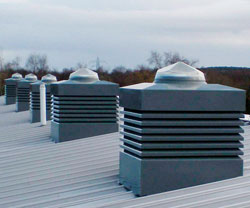Proper Roof Ventilation
Just about everyone understands the importance of having a roof that’s in good shape. However, what many people forget is the impact that their home’s roof can have on their monthly utility bill. If a roof isn’t properly ventilated, it can actually increase energy costs for the rest of a home. Although the last thing anyone wants to do is pay more than necessary for their utilities, the good news is it’s not very difficult to correct this issue.
Why Does a Roof Need Ventilation?
Quite a few researchers have spent the last twenty to thirty years looking at the best ways to minimize homes’ energy consumption while still ensuring that they are comfortable spaces during all months of the year. In addition to using plenty of insulation, one of the main conclusions that has come from this research is the need for proper roof ventilation. Despite this proven research, there are still quite a few misconceptions about ventilation.
One of the most common is that adding ventilation will allow cold air into a house. Because many people make this assumption, they actually think ventilation will increase their home’s energy usage. However, the reason this isn’t how roof ventilation actually works is because this process takes place independently of the rest of your home. As a result, the air that is pulled in isn’t being spread through your entire home. Instead, it’s going through your home’s loft space to ensure that air isn’t allowed to stagnate or overheat.
What Happens If a Roof Isn’t Ventilated?
While increased energy costs definitely aren’t a benefit, that’s actually not the worst potential effect of having a roof that isn’t ventilated. The biggest problem that can result from having a roof that lacks proper ventilation is an accumulation of moisture. If this occurs, it’s very likely to lead to mold growth. Not only can mold growth cause structural damage and respiratory complications, but it’s nearly impossible to get rid of without addressing the core reason for its growth.
Tips for Proper Roof Ventilation
To ensure you get the best results from your roof ventilation, you need to make sure you:
- Use the correct types of vents
- Comply with your roof manufacturer’s warranty
- Properly insulate your home’s loft space

Categories
- Home
- Types Of Loft Ventilation
- Attic Ventilation
- Heat Recovery Ventilation
- Industrial Loft Ventilation
- Loft Roof Space Ventilation
- Natural Ventilation
- Pigeon Loft Ventilation
- Positive Pressure Loft Ventilation System
- Proper Roof Ventilation
- Roof Ventilation
- Soffit Loft Ventilation
- Solar Ventilation
- Loft Ventilation Companies
- Loft Ventilation Information
- Loft Ventilation Products
